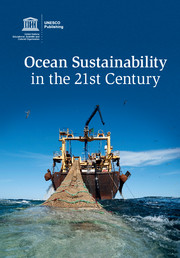Book contents
- Frontmatter
- Contents
- List of contributors
- Acronyms and abbreviations
- Foreword by Irina Bokova, Director-General of UNESCO
- Foreword by Thomas E. Lovejoy
- Preface
- Acknowledgements
- 1 Issues regarding oceans and opportunities: an introduction to the book
- 2 Main human uses of ocean areas and resources, impacts, and multiple scales of governance
- 3 Physical and chemical changes in the ocean over basin-wide zones and decadal or longer time-scales: perspectives on current and future conditions
- 4 Knowledge and implications of global change in the oceans for biology, ecology, and ecosystem services
- 5 A new perspective on changing Arctic marine ecosystems: panarchy adaptive cycles in pan-Arctic spatial and temporal scales
- 6 Ecosystem approach and ocean management
- 7 Challenges in using valuation in ecosystem-based management in a marine context: the case of UK Marine Protected Area designation
- 8 The contribution of international scientific cooperation and related institutions to effective governance for the oceans: the cases of regional tsunami early warning systems and the Argo project
- 9 Emerging and unresolved issues: the example of marine genetic resources of areas beyond national jurisdiction
- 10 The assumption that the United Nations Convention on the Law of the Sea is the legal framework for all activities taking place in the sea
- 11 The legal regime of outer space in light of the Law of the Sea
- 12 Towards sustainable oceans in the 21st century
- Index
- References
6 - Ecosystem approach and ocean management
Published online by Cambridge University Press: 05 May 2015
- Frontmatter
- Contents
- List of contributors
- Acronyms and abbreviations
- Foreword by Irina Bokova, Director-General of UNESCO
- Foreword by Thomas E. Lovejoy
- Preface
- Acknowledgements
- 1 Issues regarding oceans and opportunities: an introduction to the book
- 2 Main human uses of ocean areas and resources, impacts, and multiple scales of governance
- 3 Physical and chemical changes in the ocean over basin-wide zones and decadal or longer time-scales: perspectives on current and future conditions
- 4 Knowledge and implications of global change in the oceans for biology, ecology, and ecosystem services
- 5 A new perspective on changing Arctic marine ecosystems: panarchy adaptive cycles in pan-Arctic spatial and temporal scales
- 6 Ecosystem approach and ocean management
- 7 Challenges in using valuation in ecosystem-based management in a marine context: the case of UK Marine Protected Area designation
- 8 The contribution of international scientific cooperation and related institutions to effective governance for the oceans: the cases of regional tsunami early warning systems and the Argo project
- 9 Emerging and unresolved issues: the example of marine genetic resources of areas beyond national jurisdiction
- 10 The assumption that the United Nations Convention on the Law of the Sea is the legal framework for all activities taking place in the sea
- 11 The legal regime of outer space in light of the Law of the Sea
- 12 Towards sustainable oceans in the 21st century
- Index
- References
Summary
6.1 Introduction
The concept of an ecosystem approach has arisen largely as a management response to decline in biodiversity and natural resources, which single species management and primarily sectoral approaches had failed to stem. Because of its integrated nature, an ecosystem approach was seen as a way to better manage multiple impacts on environments holistically while maximizing long-term economic, social, and cultural bene benefits. The ecosystem approach also provides for the involvement of a wide range of users and other stakeholders in the management of a spatial area and resources, thus improving coordination and integration in activities.
Many different ‘ecosystem approaches’ exist, ranging from traditional/indigenous approaches to those more recently adopted by Western societies. The theory of how to manage using the ecosystem as the planning framework is still in its infancy and there is no one correct way to implement an ecosystem approach. However, certain principles apply to all current approaches. Perhaps the two bestknown concepts are the complementary ones in use by the Food and Agriculture Organization of the United Nations (FAO) (Garcia et al., 2003) and the Convention on Biological Diversity (CBD) (UNESCO, 2000; Shepherd, 2008) with related biodiversity conventions. In practice, however, the most widely implemented approaches are in integrated coastal zone (sometimes area) management (ICZM) and integrated water resources management (IWRM), also sometimes expressed as river basin management (RBM). While not formally called ‘ecosystem approaches’, they espouse the use of a whole or integrated system as the base layer for all planning and management.
Approaches to management that use the ecosystem as a basis have become a central concept in the implementation of a number of international and regional agreements, such as those within the CBD (cf. CBD, 2000) and the FAO Code of Conduct for Responsible Fisheries (FAO, 2013), the Convention on the Conservation of Antarctic Marine Living Resources (CCAMLR; cf. Fabra and Gascón, 2008), the Convention for the Protection of the Marine Environment of the North-East Atlantic (OSPAR), and the Helsinki Commission (HELCOM) – among others.
- Type
- Chapter
- Information
- Ocean Sustainability in the 21st Century , pp. 127 - 145Publisher: Cambridge University PressPrint publication year: 2015
References
- 1
- Cited by

